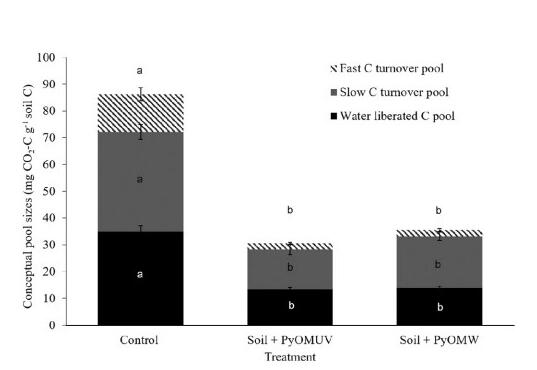Photooxidation of Pyrogenic Organic Matter Reduces Its reactive, Labile C Pool and the Apparent Soil Oxidative Microbial Enzyme Response
The surface chemistry of pyrogenic organic carbon (PyOM) can be changed by a variety of abiotic and biotic oxidative and adsorption/ desorption processes in the environment. Exposure of PyOM to high energy light prior to addition to soil or sediment, or while entrained in the atmosphere, may induce significant surface photooxidation, i.e., photochemical weathering, altering its environmental reactivity. Current researches has been mainly focused on the biogeochemical dynamics of fresh instead of weathered PyOM.
Dr. WANG Ruzhen in Research Group of Soil Chemistry of IAE and Prof. Timothy Filley from Purdue University of the US reported on a 30-day soil incubation experiment testing the effect of the photochemical weathering of a 13C-enriched ponderosa pine PyOM on PyOM and native soil organic carbon (NSC) mineralization. PyOM C mineralization was measured for both the photochemically weathered (i.e. UV treated PyOM or PyOMUV) and PyOM not exposed to high-energy light (i.e. PyOMW serving as a dark control).
The results showed that PyOMW exhibited a 3.7 times faster C mineralization rate across the 30-d study, which was driven by a large early mineralization of accessible/labileC during the first 6 d. In contrast, PyOMUV had faster C mineralization rates in the later part of the experiment(days 11–30). Overall, PyOMUV had a 13% lower net C mineralization than the untreated PyOMW where the MRT of accessible PyOMUV-C and PyOMW-C was calculated at 25.7 ± 6.8 d and 1.7 ± 0.2 d, respectively. Both forms of PyOM promoted a similar net reduction in NSC mineralization (i.e., negative priming) of approximately 50% relative to the unamended, control soil. Addition of either PyOM form resulted in an equivalent minor decrease in the concentration of extractable soil lignin phenols and substituted fatty acids chemistry with respect to the unamended soil. At 30 d, soil phenol oxidase and peroxidase enzyme activities were higher with additions of either form of PyOM compared with the unamended control soils with PyOMUV exhibiting lower activities than PyOMW. Our results indicate that PyOM photochemical weathering can impart important changes to short-term PyOM reactivity and soil microbial activity, which could have important implications for soil systems by ultimately lowering turnover rates for both NSC and PyOM-C.
The results were published in Geoderma, entitled as Photooxidation of pyrogenic organic matter reduces its reactive, labile C pool and the apparent soil oxidative microbial enzyme response. The research was funded by the National Science Foundation, the National Science Foundation of China, and the China-U.S. Eco partnership for Environmental Sustainability.
Publication Name:WANG Ruzhen et al.
Email:ruzhenwang@iae.ac.cn.
Fig. 1 The effect of PyOM additon on soil C pools(Image by WANG Ruzhen)




